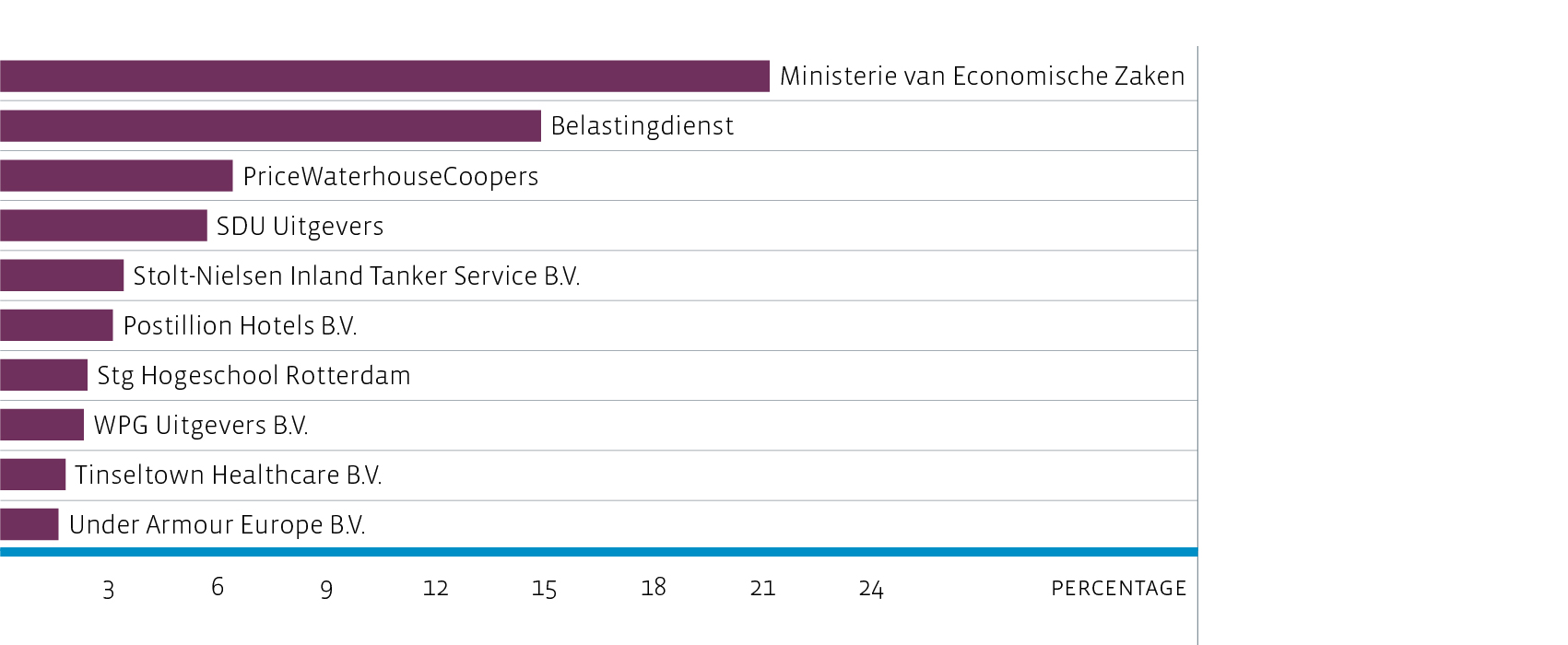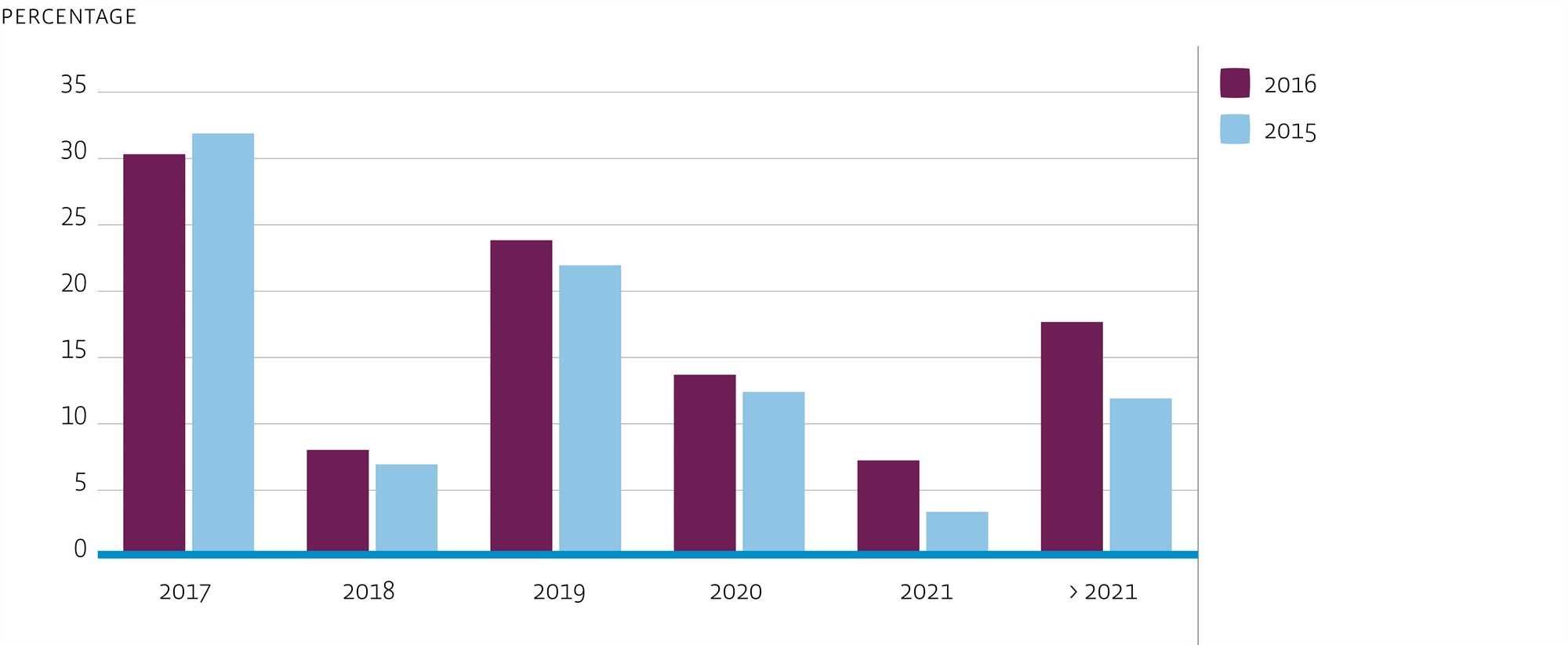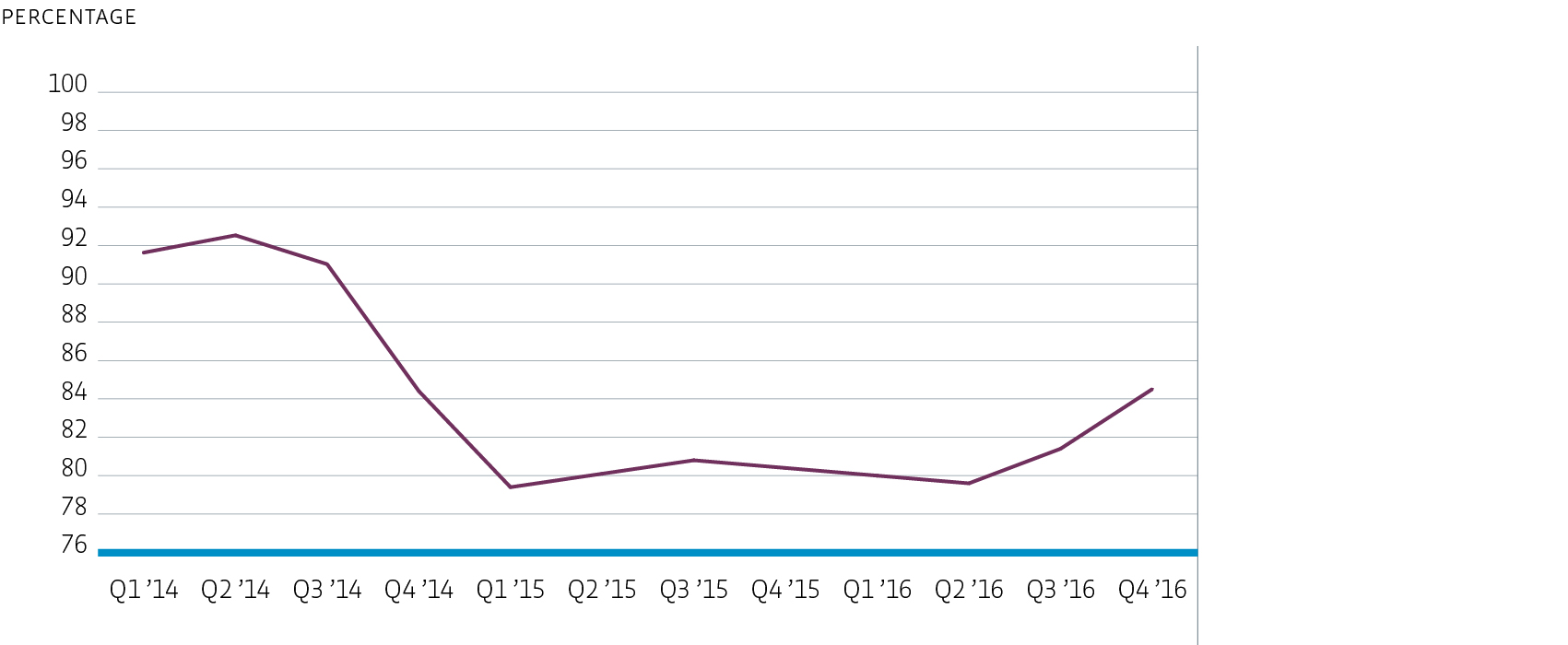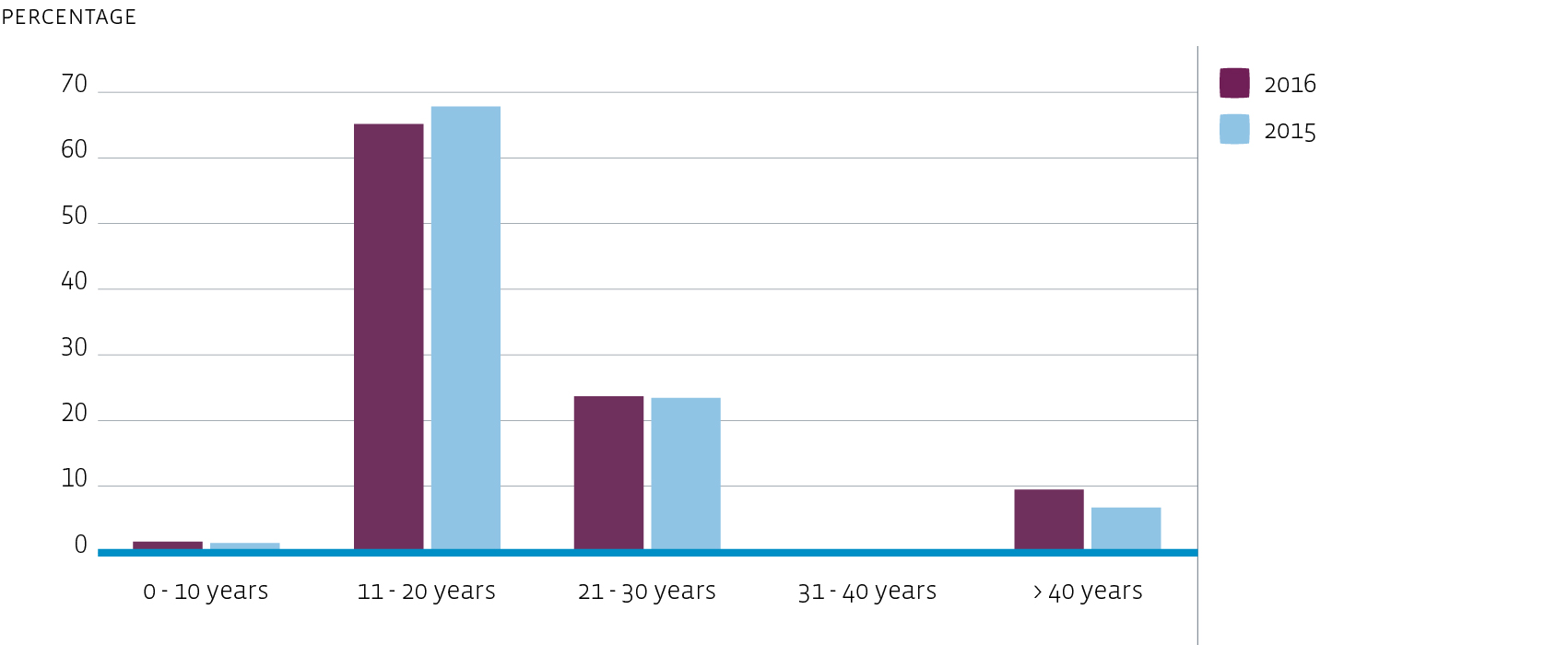Portfolio composition at year-end 2016:
16 properties, all in the G4
213,186 m² of lettable floor space
Total value investment property € 503 million
Diversification guidelines and investment restrictions
During the financial year, the Fund adhered to its diversification guidelines and investment restrictions.
Diversification guidelines | Current portfolio | Conclusion |
≥ 80% of investments invested in the core regions | 100.0% in core regions | Compliant |
≥ 90% of investments invested in low or medium risk categories | 100.0% in low and medium risk | Compliant |
Investment restrictions when the total investments of the Fund are > € 750 million | | |
< 15% invested in single investment property | There are two investment properties exceeding 15% (*) | N/A |
< 10% invested in non-core office properties | 7.9% concerns non-core office properties (2 public parking assets) | Compliant |
No investments that will have a material adverse effect on the Fund’s Diversification Guidelines. | There have been no investments in 2015 that have a material adverse effect on the Fund's diversification guidelines | Compliant |
Restrictions on (re)development activities < 5% of the Fund's total investment portfolio value | | |
a. only Assets from the Fund's porfolio qualify for (re)development | In 2016 all (re)development activities were executed only for assets of the Fund's portfolio | Compliant |
b. the activities are exclusively targeted at optimising the quality of the portfolio | All activities were targeted at optimising the quality of the Fund portfolio | Compliant |
c. not allowed if it has a negative impact on the Fund’s Diversification Guidelines | There was no negative impact on the Fund's diversification guidelines | Compliant |
d. signed commitments relating to at least 60% of the rental income of the Asset is required
| Commitment > 60% | Compliant |
e. (re)development is undertaken by and for the risk and account of Bouwinvest Office Development, a wholly owned subsidiary of the Fund | All (re)development activities are undertaken by and for the risk and account of Bouwinvest Office Development | Compliant |
f. all financial risks in connection with the work to be conducted as part of the (re)development will be contractually excluded by Bouwinvest Office Development and transferred to external developers or contractors. Examples of such risks are: design and building risks and cost and planning risks | All financial risks in connection with the work to be conducted as part of the (re)development are contractually excluded by Bouwinvest Office Development and transferred to external developers or contractors | Compliant |
g. zoning risks remain with the Fund, however starting the building activities in relation to a (re)development is conditional upon obtaining the relevant zoning permits | The building activities in relation to a (re)development were conditional upon obtaining the relevant zoning permits | Compliant |
(*) The total value of investment property in the Fund is € 503 million, so the restriction is not yet applicable.
Investments, divestments and redevelopments
In 2016, the Fund acquired the Hourglass office development project in Amsterdam’s Zuidas business district, which once completed, will constitute a major optimisation of the Fund’s portfolio. In the same period, the Fund invested a total of € 14 million in redevelopments, renovations and sustainability upgrades.
Acquisitions
The Hourglass building consists of 22,000 m² of multi-tenant office space, 15,000 m² of which will be leased to top Dutch law firm Loyens & Loeff, together with 700 m² of space for retail and catering units and 145 parking spaces. Loyens & Loeff has several options to expand their leased spaces. Seller, Sax Vastgoed (Maarssen Groep and Brouwershoff) have provided a lease guarantee for the remaining spaces. Hourglass also includes a 115-room extended stay hotel and restaurant open to the public. The hotel will be let to international operator PREM Group, which will cater to the office tenants in the Hourglass and meet the growing demand from the many Dutch and international companies based in the Zuidas business district with its Premier Suites living environment concept. The Hotel section of the Hourglass building will be added to Bouwinvest’s Hotel Fund portfolio.

Divestments
The Fund made no divestments in the year under review.
Redevelopments
In 2016 the Fund kicked off the redevelopment of the former Citroën buildings in Amsterdam, which have been renamed The Olympic 1931 and The Olympic 1962. Based on a decision about the total investment in May, selected architects Rijnboutt and Biermann Henket have proceeded with their designs and applied for two building permits. Meanwhile, Lokhorst Bouw en Ontwikkeling has been assigned as buidling contractor. As the Fund has received the building permits, real execution of construction works has already started. Delivery is currently scheduled for he first quarter of 2018.
In addition to redevelopments, various other projects involved investments in property upgrades, including improvement of sustainability. This so called capital expenditure was mainly related to the modernisation of several high rise office floors in WTC Rotterdam, an improved entrance for WTC The Hague and asset optimisations for Nieuwe Vaart in Utrecht to facilitate a "caring is sharing" concept, which was developed in close cooperation with a cluster of like minded organisations with a strong CSR policy.
Optimising the risk-return profile
In terms of risk diversification, at least 90% of the investments must be low or medium risk.
The actual risk allocation as at year-end 2016 is shown in the figure below. Every year, all properties are assessed separately. In 2016, the Fund was classified as 100% low to medium risk and as such was consistent with the framework of the Fund conditions.
As of 2017 a new risk questionnaire will be applied and will cause a shift in the portfolio composition. Future investments related to the WTC Rotterdam, The Olympic 1931 and 1962 and Hourglass in Amsterdam will further lower the risk profile of the Fund.
Portfolio composition by risk category based on market value

Portfolio diversification
Focus on central locations in core regions
To identify the most attractive municipalities for office investments, the Fund takes into account indicators such as:
At year-end 2016, 100% of the Fund's assets were located in the four prime office regions; Amsterdam, Rotterdam, The Hague and Utrecht.
Both the acquisition of Hourglass in Amsterdam in 2016, once completed, and the redevelopment of The Olympics will improve diversification, reducing the share of especially the portfolio in The Hague in particular and increasing the proportion of assets in the capital city.
Portfolio composition by core region based on market value

Focus on multi-tenant, multifunctional, multimodal office concepts
Multiple lease agreements reduce the volatility of revaluations and help increase the control of asset management risks. Furthermore, the Fund focuses on locations that attract a widely diverse group of people and offer a mix of culture, education, sport and work facilities.
The share of multi-tenant assets in the portfolio increased to 94.4% in 2016 (94.2% in 2015).
Portfolio composition by single vs multi-tenant based on market value

Tenant mix
Most of the Fund's tenants are considered to have a low debtor's risk. The top ten tenants account for a total of 62.8% (2015: 62.4%) of the passing rent. The Fund negotiated leases with a number of new and existing tenants in 2016, closing leases for 15,509m² of office space and annual rent of € 2.9 million. We maintain close relationships with all tenants to ensure satisfied customers.
Portfolio composition by tenant sector as a percentage of rental income

The Office Fund’s top 10 tenants

Active asset management – building value
The Fund devotes a great deal of attention to improve occupancy levels by developing close relationships with tenants and property managers. Thanks to its excellent customer focus, knowledge, experience and a broad network, the Fund is able to respond (pro-actively) to users’ changing requirements for office space. Because of this pro-active approach, in-house expertise and a focus on sustainable partnerships with public and private parties, the Fund is able to add value to its assets. The Fund frequently acquires and transforms previously underperforming assets into high-quality office complexes that meet the needs of today’s – and tomorrow’s – office tenants.
Expiry dates
Expiry dates as a percentage of rental income

The relatively high percentage of expiry dates in 2018 and 2019 is a result of the potential termination of leases with two large tenants. The average remaining lease term stood at 2.8 years, 0.4 less than the 3.2 years at year-end 2015.
Close relationships with tenants enable the Fund to propose lease extensions at the right time. However, lease endings are taken into account and the Fund anticipates this to attract new tenants.
WTC The Hague
WTC The Hague is a prime example of an office building of the future. Based in a multifunctional location, offering flexible office concepts and services to a variety of large and smaller businesses, WTC The Hague is a frontrunner in its region.
In 2016, the Fund completed several measures to further optimise WTC The Hague, including the upgrade of the central entrance area, making it a more pleasant and dynamic business meeting place and improving the image and positioning of the building as a whole. The upgrade has created a single entrance to the WTC, with all the facilities and services arranged around that entrance. The changes made included:
the service desk is now the central point where the hostess greets visitors and users of the building;
the Coffee Company has been relocated, which has created a direct entrance from the street side. This has increased the visibility of the facilities in the area and attracts greater numbers of visitors;
the realisation of an ‘AH to go’ store, something that was high on the list of tenants’ wishes. The store is accessible both from the lobby and from the Beatrixlaan;
the realisation of bar-restaurant Mondano. This is now the place for a business lunch or dinner, while Mondano Kitchen offers an excellent alternative to companies’ own canteens;
the fitness area has been relocated so it is visible and accessible directly from the lobby;
the lobby has been linked up to the Fund’s thermal energy storage system.
Last year, the WTC International Business Club once again teamed up with several partners such as the WestHolland Foreign Investment Agency (WFIA), International Community Platform (ICP) and The Hague city council to organise a number of networking and business promotion events.
Last but not least, WTC The Hague was awarded a BREEAM In-Use EXCELLENT certificate for both Asset and Building Management levels. This makes WTC THe Hague the most sustainable multi-tenant office building in The Netherlands.
The Olympic 1931 and 1962
In 2016, the Fund kicked off the upgrade of the former Citroën buildings, which have been renamed The Olympic 1931 and The Olympic 1962. Delivery is currently scheduled for Q1 2018. Parallel to the realisation of the redevelopment, the Fund instigated various leasing activities. A branding strategy and house style has been developed and various marketing tools were produced. The Fund also took the initiative to draw up a document outlining the ambitions for the area, which will form the basis for a continued cooperation with the Amsterdam city council and other stakeholders in efforts to improve the public spaces around the buildings. Suitable events and amenities, together with area promotion activities, will ultimately help make the area more attractive and increase familiarity with the name: ‘The Olympic Amsterdam’. The launch of this process was accompanied by a large-scale media event, marking both the launch of the new names and the announcement of the redevelopment plans.
The leasing activities have so far resulted in provisional lease agreements with Pon Holdings for the entire The Olympic 1931 building (around 7,000 m² lfa) and with Under Armour Europe, which is planning to set up their European head office in The Olympic 1962 (around 5,000 m² lfa). We have also established a preference for a catering operator and concept on the basis of pitches from a number of catering firms. We also expect to find tenants for the remaining square meterage - around 5,000 m2 lfa office space and 1,000 m² lfa basement space – before the completion of the project.
WTC Rotterdam
Following the reorganisation of the property management for the WTC in Rotterdam and the selection of a number of new partners to realise improvements to the building in 2015, the Fund drew up concrete plans and initiated a number of projects last year. The changes to the building include an upgrade for the main entrance, Café Staal, the lobby, the access to the lifts, the Business Center, the walls of various conference rooms, including the Rotterdam Hall, the addition of flexible (retail) units and a skybar on the 23rd floor.
Finally, assessment of the feasibility to transform some of the office spaces into hotel rooms is still ongoing. The Fund also sees this change in functionality as a positive move since it would constitute a long-term solution for the vacant office space and because hotel facilities are a good fit with the WTC concept.
New leases and lease renewals
Active asset management has led to a total of new and renewed leases of 15,509 m2 and an annual rent of € 2.9 million in 2016. In many cases, new leases were a result of investments in refurbishments executed in advance to attract new tenants.
The CSR cluster headed by Oikocredit and Max Havelaar in the Nieuwe Vaart office building in Utrecht continued to expand in 2016. The Fund signed new leases for a total of 3,214 m2. The agreements include the realisation of a “caring is sharing” concept, in which the tenants share various facilities and services. These include the realisation of a shared restaurant, plus conference spaces and small office units that are available for flexible rental. The Fund and the tenants joined forces to improve the sustainability of the asset.
Following the renovation of the central entrance area of the WTC The Hague, the Fund signed new leases for a total of 3,631 m² of office space. New tenants include Sprangers Van den Ende accountants and legal advisors, SENS Real Estate, Task Force Healthcare, Tymlez BV, Women in Cybersecurity, Dong Dao, CTE Techno, Briddge, Edge Consultants, and Simplify Now. Raffemet Commodities and Staffing Associates extended their tenancy agreement.
Ongoing measures at WTC Rotterdam resulted in several new and renewed leases in 2016 to a total of 2,315 m2.
The former Citroën buildings, The Olympic 1931 and The Olympic 1962, will be classified as under construction during the remodelling and refit. The Fund has negotiated two leases for all of one building and a large part of the second and expects this office complex to be fully let upon completion of the upgrade, which is planned for the beginning of 2018.
New and renewed leases include:
Pon Holdings in The Olympic 1931 (Amsterdam)
Compare Group in Nieuwe Vaart (Utrecht)
Coöperatie van verenigingen van leraren e.a. onderwijspers in Nieuwe Vaart (Utrecht)
Infi Utrecht in Nieuwe Vaart (Utrecht)
Young Capital in Nieuwe Vaart (Utrecht)
Stichting Duurzaam Energie Kantoor in Nieuwe Vaart (Utrecht)
Stichting Nationaal Jeugd Fonds Jantje Beton in Nieuwe Vaart (Utrecht)
Financial occupancy
Financial occupancy rate
The acquisitions at the end of 2014 of WTC Rotterdam and The Olympics (former Citroën buildings) in Amsterdam have led to a decrease in the occupancy rate of the Fund. Parallel to the redevelopment of The Olympics, the Fund's letting activitities are aimed to achieving 100% occupancy for these assets as of Q2 2018, which is the current planning for their completion. Capital expenditure for WTC Rotterdam and WTC The Hague will also support new lettings. Meanwhile, the occupancy rate of Nieuwe Vaart has already benefited from investments, which was the main reason for an increase of the occupancy rate at the end of 2016.

Asset optimisation
Although the buildings in the Fund’s portfolio are relatively young, the major part is now more than 10 years old. The lay-out of these buildings therefore generally needs to be updated and modernised to keep the building lettable in today’s market. The Fund has upgraded a number of empty spaces prior to closing new lease contacts. The renovation and upgrades of the WTC in Rotterdam and the former Citroën buildings in Amsterdam, together with the completed upgrade of the WTC The Hague are perfect examples of this approach. As mentioned elsewhere, the improved sustainability of Nieuwe Vaart (formerly Arthur van Schendelstraat) office building in Utrecht led to a number of new leases with non-profit companies in the CSR sector.
Portfolio composition by age based on market value

More important than age is the asset's distinctive character, its location and return prognosis. Following the 2014 acquisition of four existing buildings, two of which have a listed status based their rich history and architecture, led to an increase in the average age of the portfolio. However, last year’s acquisition of the new-build, mixed-use Hourglass building in Amsterdam will reduce the average age of the portfolio from 2019 onwards.
Investments in sustainability also increase the chances of new leases or lease extensions, as demand for sustainable offices is growing. These investments can also cut housing expenses, which gives office buildings a competitive edge in terms of pricing.
Area promotion
As part of our ongoing drive to forge sustainable partnerships with various stakeholders, Bouwinvest has always been involved in numerous area organisations, such as the Olympic Stadium area in Amsterdam and the New Centre project in The Hague. Bouwinvest teamed up with The Hague city council and a number other companies to found the Green Business Club Beatrixkwartier. The aim of the club is the promotion of The Hague as an attractive city and the sustainable development of the Beatrixkwartier district. The idea is to improve facilities and amenities, which will include initiatives on both social and environmental fronts.
Bouwinvest is working closely with local authorities and other public and private parties on the development of the area around Amsterdam’s Olympic Stadium, recently dubbed ‘The Olympic Amsterdam’. This project will give the area – where Bouwinvest has also invested in homes, shops, the Olympic Stadium and an underground parking garage – a whole new impetus, creating a lively area where people live, work, play sports and relax.